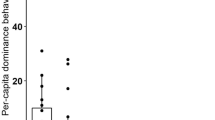Abstract
Social aggression is a pervasive feature of insect societies. In eusocial Hymenoptera, aggression among females can affect task performance and competition over direct reproduction (egg laying); in most species males participate in social interactions relatively rarely. Males of the independent-founding paper wasp Mischocyttarus mastigophorus are exceptional: they are aggressive toward female nestmates, leading us to explore the function of this unusual behavior. We applied social network analyses to data on M. mastigophorus social aggression to quantify sex differences in giving and receiving social aggression. The network analyses supported the pattern of biased male aggression toward female nestmates; females are relatively rarely aggressive to males. We then asked whether male aggression toward females was biased by females’ relative ovary development. Males were more aggressive toward females with better-developed ovaries, opposite to patterns of aggression among females. Because food brought to the colonies is often monopolized by dominant females, we suggest that males direct aggression toward socially dominant females with better-developed ovaries to obtain food. The implications of biased male aggression for female task performance and physiology are unknown.





Similar content being viewed by others
Data Availability
Behavioral data for generating the social networks and ovary development data will be published with the MS as supplementary files.
References
Bastian M, Heymann S, Jacomy M (2009) Gephi: an open source software for exploring and manipulating networks. Int ICWSM Conf 3:361–362
Clarke FM, Faulkes CG (2001) Intracolony aggression in the eusocial naked mole-rat, Heterocephalus glaber. Anim Behav 61:311–324
Cronin A, Field J (2007) Social aggression in an age-dependent dominance hierarchy. Behaviour 144:753–765
Fateryga AV (2010) Trophic relations between vespid wasps (Hymenoptera, Vespidae) and flowering plants in the Crimea. Ent Rev 90:698–705
Hart AG, Ratnieks FLW (2005) Crossing the taxonomic divide: conflict and its resolution in societies of reproductively totipotent individuals. J Evol Biol 18:383–395
Heinze J (2016) The male has done his work—the male may go. Curr Opin Ins Sci 16:22–27
Ito Y (1985) A comparison of frequency of intra-colony aggressive behaviours among five species of polistine wasps (Hymenoptera: Vespidae). Zeit Tierp 68:152–167
Jeanne RL (2009) Vibrational signals in social wasps: a role in caste determination? In: Gadau J, Fewell J (eds) Organization of insect societies. Harvard University Press, Cambridge, pp 241–263
Kilgour RJ, Norris DR, McAdam AG (2020) Carry-over effects of resource competition and social environment on aggression. Behav Ecol 31:140–151
Lamba S, Chandrasekhar K, Gadagkar R (2008) Signaling hunger through aggression— the regulation of foraging in a primitively eusocial wasp. Naturwissenschaften 95:677–680
Lawless JF (1987) Negative binomial and mixed Poisson regression. Canad J Stat 15:209–225
Markiewicz DA, O’Donnell S (2001) Social dominance, task performance and nutrition: implications for reproduction in eusocial wasps. J Comp Physiol A 187:327–333
Molina Y, O’Donnell S (2008) A developmental test of the dominance-nutrition hypothesis: Linking adult feeding, aggression, and reproductive potential in the paperwasp Mischocyttarus mastigophorus. Ethol Ecol Evol 20:125–139
Molina Y, O’Donnell S (2009a) Worker reproductive competition affects division of labour in a primitively social paperwasp (Polistes instabilis). Ins Soc 56:14–20
Molina Y, O’Donnell S (2009b) Males exhibit novel relationships of dominance with nest departure in the social paper wasp Mischocyttarus mastigophorus (Hymenoptera: Vespidae). Ethol 115:738–746
Monnin T (2006) Chemical recognition of reproductive status in social insects. Ann Zool Fenn 43:515–530
O’Donnell S (1998) Dominance and polyethism in the eusocial wasp Mischocyttarus mastigophorus (Hymenoptera: Vespidae). Behav Ecol Sociobiol 43:327–331
O’Donnell S (1999) The function of male dominance in the eusocial wasp Mischocyttarus mastigophorus (Hymenoptera: Vespidae). Ethology 105:273–282
O’Donnell S (2001) Worker biting interactions and task performance in a swarm-founding eusocial wasp (Polybia occidentalis, Hymenoptera: Vespidae). Behav Ecol 12:353–359
O’Donnell S, Joyce FJ (2001) Seasonality and colony composition in the tropical eusocial wasp Mischocyttarus mastigophorus Richards (Hymenoptera: Vespidae). Biotropica 33:468–473
O’Donnell S, Fiocca K, Campbell M, Bulova S, Zelanko P, Velinsky D (2018) Adult nutrition and reproductive physiology: a stable isotope analysis in a eusocial paper wasp (Mischocyttarus mastigophorus, Hymenoptera: Vespidae). Behav Ecol Sociobiol 76:86
Spradbery JP (1973) Wasps: an Account of the Biology and Natural History of Solitary and Social Wasps. University of Washington Press, Washington
Starks PT, Poe ES (1997) ‘Male-stuffing’ in wasp societies. Nature 389:450
Wey T, Blumstein DT, Shen W, Jordan F (2008) Social network analysis of animal behaviour: a promising tool for the study of sociality. Anim Behav 75:333–344
Funding
University of Washington Royalty Research Fund (to S. O’D.).
Author information
Authors and Affiliations
Contributions
S. O’D. wrote the MS and performed statistical analyses; KF and RC performed the social network analyses and edited the MS.
Corresponding author
Ethics declarations
Ethics Approval
Research permits for field work were obtained from the Costa Rican Ministry of Natural Resources, Energy and Mines (to Francis J. Joyce Jr.).
Consent for Publication
All authors have read and approved submission of this version for publication.
Conflict of Interest
The authors declare no conflicts of interest.
Additional information
Publisher's Note
Springer Nature remains neutral with regard to jurisdictional claims in published maps and institutional affiliations.
Rights and permissions
About this article
Cite this article
O’Donnell, S., Fiocca, K. & Congdon, R. Social Network Analysis of Male Dominance in the Paper Wasp Mischocyttarus mastigophorus (Hymenoptera: Vespidae). J Insect Behav 34, 106–113 (2021). https://doi.org/10.1007/s10905-021-09774-0
Received:
Revised:
Accepted:
Published:
Issue Date:
DOI: https://doi.org/10.1007/s10905-021-09774-0




